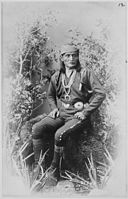Social and Political Organization
Most of our information about the social organization of the Zuni comes from the late 19th or early 20th centuries, by which time it almost certainly had been modified from that of the pre-contact period. Changes in Zuni society likely accompanied the consolidation that occurred in 1692, as the population shifted from living in six separate villages to one. Additionally, Spanish and European policies have similarly contributed to changes in Zuni society. Traditional Zuni society was theocratic, with power vested largely in the hands of the Priestly Council. This council was responsible for selecting and installing the governor and tribal council, two institutions created by the Spaniards, as well as selecting and installing various traditional religious officials. Although once quite powerful, in the early 1900s the Council of Priests lost much of its power due to policies by the federal government (see below). Since 1934, secular power has been concentrated in a democratically elected tribal council which was created when the Zuni accepted the Indian Reorganization Act.Thus, Zuni government has shifted from a theocracy to a democracy.
|
|
Pahlowahtiwa, Governor of Zuni, 1899 Source - https://commons.wikimedia.org/wiki/File%3APaliwahtiwa%2C_Governor_of_Zuni%2C_full-length%2C_seated_-_NARA_-_530901.jpg
|
Like the Hopi, the Zuni were matrilineal and matrilocal. However, the matrilocal clans had less power than they did among the Hopi, and it was the household—not the clan—that was the basic economic, social, and religious unit. At Zuni, clan function was largely limited to the regulation of marriage through clan exogamy.
Click on next page to continue.

